How do I...
Japanese Gardens at the Library
A garden in Japanese culture is one of the highest art forms, expressing the essence of nature. The art of gardening was probably imported to Japan by the sixth century A.D. and has developed many styles since then. There are many well-known Japanese gardens in California such the Huntington Library Botanical Gardens in San Marino, California; Descanso Gardens in La Canada Flintridge, California; the Japanese Tea Garden in San Francisco, California's Golden Gate Park.
The County Library has Japanese gardens in two of its libraries: the Culver City Julian Dixon Library and the Gardena Mayme Dear Library.
Kaizuka Meditation Garden - Culver City Julian Dixon Library
The Meditation Garden gracing the front of the Culver City Julian Dixon Library was a gift from the people of Kaizuka City, Japan, to the people of Culver City, California, for the hospitality provided by Culver City citizens to Kaizuka athletes and Olympic officials and Kaizuka dignitaries.
The Kaizuka City Sister City Program began shortly after the 1962 visit from the Japanese Women's Volleyball Team after they won the World Championship from the Soviet Union Team. The entire volleyball team was hosted by Culver City residents and returned to Kaizuka City full of praise for the warmth and kindness shown them by the people of Culver City.
After the visit, the Mayor of Kaizuka City, Yoshio Okamoto, asked the City of Culver City to become their Sister City. This marked the first time in the history of the International Sister City Program that a foreign city asked an American city to affiliate with them as a Sister City. The people of Kaizuka City felt there needed to be a permanent bond of brotherhood and friendship. The Meditation Garden is the result of many years of planning.
To give the garden complete authenticity, it was planned and fully constructed by Kaizuka engineers in Japan, then dismantled and sent to Culver City for assembly. Lanterns, a waterwheel, a bridge and other artifacts, and rocks weighing as much as 12 tons were shipped to Culver City and reconstructed by the engineers who had designed it. The trees, shrubs and flowers were supplied locally.
The completed garden was dedicated on April 21, 1974, in a Japanese ceremony, with a Shinto priest officiating. The people of Culver City warmly accepted the gift of friendship from their sister city, Kaizuka. The garden is a continuing source of pleasure, inspiration and enjoyment for our citizens and visitors. The garden can be viewed from the front of the building on Overland Avenue.
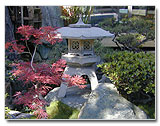

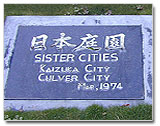
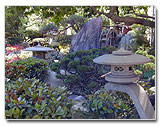

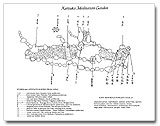
Japanese Garden - Gardena Mayme Dear Library
The Gardena Library was dedicated on December 5, 1964. A major focal point of the library is the Japanese garden that represents one of the great arts practiced by the Japanese people. The landscape design for the Gardena Library's garden was prepared by Takuma P.Tono, Professor of Landscape Architecture at the Tokyo Agriculture University.
The central feature of the garden, a Kasuga-Toro (stone lantern), is 150 years old and weighs 2,024 pounds, standing seven feet tall. It is a gift from the City of Ichikawa to her Sister City, Gardena. The KasugaToro is a family relic belonging to Yoshio Konagi, past president of the Ichikawa Rotary Club, who donated the lantern in commemoration of the Sister City affiliation that exists between Gardena and Ichikawa.
The landscape materials consist of 35 tons of moss-backed ornamental rocks (the largest one weighing four tons), which were located in the Ojai-Santa Paula area and given as a gift to Los Angeles County by Ventura County. All trees and shrubs were selected to meet design requirements.
The Tsuku-Bai (water basin) is used to purify oneself by rinsing mouth and hands before entering a Japanese home. The raked sand expresses wave pattern of water while the logs are used for erosion prevention and decorative effect.
Sodegaki (bamboo) fencing serves an ornamental purpose and the background shrubs are to represent a forest. Within the garden, rocks are arranged in odd numbers with smooth flat rocks representing turtles and the upright type representing cranes, both of which are symbolic of long life in Japanese folklore.
This beautiful garden was the creative effort of the Gardena Valley Gardeners Association and represents 2,620 hours given by the members of the Association: President Kay Iizuka, General Chairman Frank Okada, Design Committee Chairman Mas Nakano, Project Consultant Art Ishida, Assistant Project Consultants Haruo Yamashiro and Kenny Uyeda, Materials Committee Chairman Ralph K. Ota, Construction Committee Chairman Nick Kats
The garden can be viewed from the interior of the Gardena Library during the library's open hours.



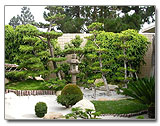

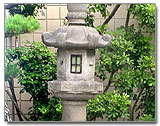
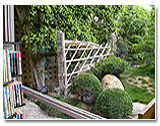
Reading List

-
Uses materials and plants readily available in North America

-
Offering a "how-to" approach, this compilation of essays focuses on the inherent principles and practices behind Japanese landscape design. From creating garden paths to installing rocks and using water, the essential elements of Japanese gardens are addressed from both philosophical and practical points of view.
-
Picture book of contemporary garden details.
-
-
This book makes it possible for anyone to bring a touch of Oriental magic into his or her own back yard. The basic components of a Japanese garden and their functions are explained and illustrated in full color: stepping stones, statues, waterfalls, ponds, bamboo fences and gates, and more.
-
